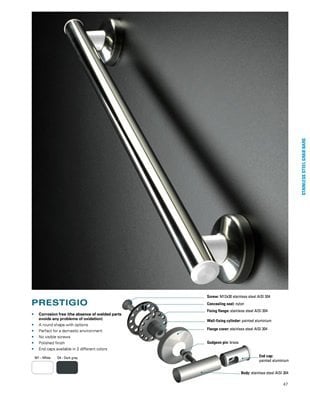Grab bars are one of the easiest home improvements to add for seniors who want to age in place. Aging in place is, for many seniors and their families, an ideal situation. As more seniors in the Baby Boomer generation face decisions about their futures and local governments work to provide adequate housing for multi-generational families, many seniors are hoping to age in place at home or with family. The main concerns for seniors who age in their own homes or with friends or relatives typically revolve around safety. Caregivers ask questions about whether or not seniors can access medical care in case of an emergency, check living spaces for potential trip-and-fall risks, and consult with medical professionals about the kind of care their loved one needs. For professional caregivers that visit a senior’s home to provide care, knowing the available changes to make in order to ensure senior safety is a great way to help keep seniors safe at home. One key way to do this is to understand grab bars and what kinds a senior might need.
Grab bars
Grab bars are a typically simple piece of equipment that get installed into a wall and help a senior support themselves while they move through activities of daily living. Whether they are installed in a shower, staircase, or hallway wall, grab bars offer seniors a safe way to move around while also fostering independence. Essentially, these bars allow seniors to grab hold of something to steady themselves as they stand, walk, or transition between standing and walking. Especially in slippery or precarious situations, such as stairs or bathrooms, grab bars offer peace of mind to caregivers, who can assist seniors or allow them to perform activities of daily living alone, but safely.
Types of grab bars
There are many varieties of grab bars, and they serve various purposes. A typical grab bar looks much like this photo, courtesy of SafetyInPlace.com:

As you can see from this photograph, grab bars are more complicated than they look. In order to ensure structural soundness (and, therefore, safety), they are designed with specialized internal parts. These make sure that grab bars hold up to body weight and pressure from someone pulling on them or resting against them. Below you can see two examples of grab bars installed in bathroom spaces.

Grab Bar Options
The bottom bar, placed near a sink and in a bathroom, allows a senior to support themselves as they walk or stand up during normal bathroom activities. Since it is installed into the wall, it can hold up to the pressure of someone’s body weight. Using this bar, seniors require less or no assistance during bathroom activities. Anyone who cares for seniors will say that fostering independence and safety during such private activities helps maintain their dignity and avoids tension and discomfort around bathroom use.
The top bar pictured serves two functions: it is a grab bar, installed properly to be used for safety, but also blends well with functional and aesthetic bathroom purposes, acting as a towel rack for drying hands. This goes to show that safety equipment actually can add value to a space beyond safety, effectively increasing the worth of a senior’s home. In fact, if you did not know it could serve as a grab bar, you might suppose it is just a beautiful accent in a bathroom design; those in the know, however, would recognize that investment and see its aesthetic and safety value.
Similar equipment for safety
Grab bars are not the only safety equipment upgrades available for seniors aging in place. Seated showers and customizable showerheads also help seniors safely bathe. A senior with arthritic knees, for example, can spend most of their bathing time seated, holding a showerhead or moving it closer to the ground. This way, they can bathe themselves and require limited assistance. The showerhead can also move up and down an installed grab bar, making getting up and sitting down even safer on slippery shower surfaces. As you can see from the photographs below, these showers offer seniors a comfortable way to remain safe and maintain their independence.


Choosing safety equipment
When making decisions about safety equipment such as grab bars or altered shower equipment, the most important priority is the needs of the senior. Are they able to walk without much assistance, but worry about slip-and-fall incidents that can cause fatal injuries? They may only need a grab bar near slippery floors, such as in a bathroom or down a staircase as a railing. Does the senior in your care need help standing up and sitting down? They might need grab bars near their bed or favorite chair, even. Does pain or limited mobility make bathing dangerous, especially when standing for a length of time? They might need grab bars and a seated shower. Regardless, take the time to chat with other caregivers, the senior, and any family members. Look into price options, safety recommendations, and shared priorities. By evaluating the needs of a senior to be independent and any safety concerns, balanced by a budget, you have a chance to provide safety and support for their decision to age in place.
Sources:
AARP. Aging in Place: A Toolkit for Local Governments. AARP.org. Available at http://www.aarp.org/content/dam/aarp/livable-communities/plan/planning/aging-in-place-a-toolkit-for-local-governments-aarp.pdf. Retrieved May 5, 2017.
National Aging in Place Council. About Us. AgingInPlace.org. Available at http://www.ageinplace.org/About-Us/Our-Mission. Retrieved May 1, 2017.
SafetyInPlace.com. Grab Bars. Safety In Place. Available at https://safetyinplace.com/collections/grab-bars. Retrieved May 1, 2017.
Note: if you see your organization sourced here, we would appreciate a link back to www.seasons.com and a follow @seasons on Twitter.
